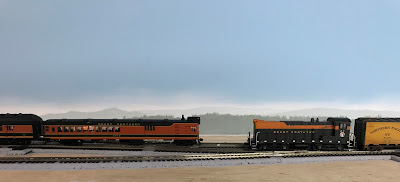 |
| Trestle scene ready for ground cover |
The initial landforms around the trestle are now complete other than adding detailed texturing with gravel, soil, ground foam, shrubbery, trees, and water. In this post, I will continue to describe the steps I went through to get to get here from where I left off in a
previous post.
 |
| Fascia clamped in place |
While the land forms were roughed in with cardboard webbing and plaster cloth, they needed another layer before I applied paint or ground cover. Since the basic shapes we're present, I went ahead and cut the fascia panel for the bottom of the "U" seen in the photo. While I was cutting that fascia panel, I also cut the ones to finish off the Willow Springs side of the layout. After clamping the panel in place, I noticed that, in addition to gaps appearing between the scenery and the fascia, the cardboard webbing telegraphs through to the surface much more than I liked.
 |
| Materials |
My plan was to make a batch of rock castings, apply a layer of Sculptamold, and then apply the rock castings. I started by spraying the rock mold with wet water and mixing up some Hydrocal plaster. I mixed the plaster in a disposable plastic sour cream cup to avoid rinsing plaster down the drain. Following the AAP protocol (Always Add Plaster) I mixed plaster to the water in the cup until it was the consistency of a milkshake. After I filled the molds, I had a lot of plaster left.
This is where I went off plan. I decided to pour the remainder of the plaster into the river bottom and spread it out. While I was not yet really happy with the way it was smoothing out, the plaster started setting up. I rushed out to our driveway and collected some gravel and small rocks. I pressed some of the rocks and gravel into the plaster, pressed the hardening plaster into the banks with a putty knife, and smoothed out a path for the stream itself.
Back to the original plan. I mixed up some Sculptamold using recent dollar store purchases: a plastic bowl and rubber spatula. Then using a combination of the spatula, a putty knife, and my fingers I applied a layer of the Sculptamold to the hillside. My goal with this application was to hide the webbing contours and the mini-holes from the plaster gauze.
 |
| Staining the rock castings |
After cleaning up the Sculptamold tools, it was time to release the rocks from the mold. I had read in a Dave Frary scenery
book that he liked to stain the castings while they were still "green" or not completely set up. I mixed a new jar of stain with about half and half 70% alcohol and water with a few drops of India ink. Then I used an orange-brown craft paint and a black acrylic to apply additional washes, wet-on-wet, to the castings. As the rocks dried, I experimented with different placements in the cut approaching the trestle and along the creek banks.
 |
Castings on the cut and real rocks in
the stream bed |
To attach the castings, I mixed up a small batch of Sculptamold to use as a cement and as a filler around the rocks. I was trying to have the rock castings appear to surface from the hillside rather than look like they were glued to the surface of the hill. When I get to the future step of applying ground textures, I will also attempt to emphasize that appearance. After this photo was taken, I mixed up more Sculptamold and applied more castings to the stream banks. I also built up some more bank at the backdrop to emphasize the appearance of the the creek curving behind the hill rather than meeting the backdrop directly.
After giving everything a day to dry, I came back and painted the hillsides with my brown base color of latex flat paint. For the stream, I used a latex black and blended the two colors for the stream bank. While I had the paint out, I painted all exposed plywood on the rest of the layout with the base brown color. Also, I attached the fascia panel and painted it with the dark Pullman green color I am using on the layout. With the completion of this layer of landform, the scenery is at a point that the track-work and operations plan can be tested before moving on to add additional textures.

